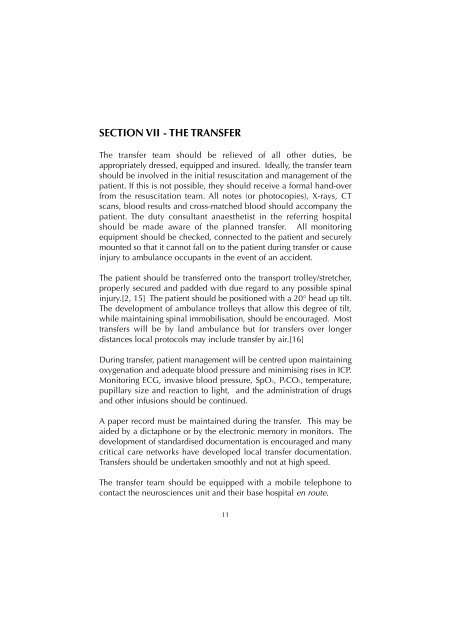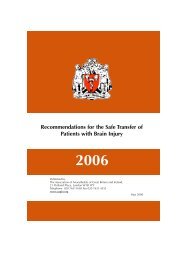TheatrePracticeStandardsGeneric1
You also want an ePaper? Increase the reach of your titles
YUMPU automatically turns print PDFs into web optimized ePapers that Google loves.
SECTION VII - THE TRANSFER<br />
The transfer team should be relieved of all other duties, be<br />
appropriately dressed, equipped and insured. Ideally, the transfer team<br />
should be involved in the initial resuscitation and management of the<br />
patient. If this is not possible, they should receive a formal hand-over<br />
from the resuscitation team. All notes (or photocopies), X-rays, CT<br />
scans, blood results and cross-matched blood should accompany the<br />
patient. The duty consultant anaesthetist in the referring hospital<br />
should be made aware of the planned transfer. All monitoring<br />
equipment should be checked, connected to the patient and securely<br />
mounted so that it cannot fall on to the patient during transfer or cause<br />
injury to ambulance occupants in the event of an accident.<br />
The patient should be transferred onto the transport trolley/stretcher,<br />
properly secured and padded with due regard to any possible spinal<br />
injury.[2, 15] The patient should be positioned with a 20° head up tilt.<br />
The development of ambulance trolleys that allow this degree of tilt,<br />
while maintaining spinal immobilisation, should be encouraged. Most<br />
transfers will be by land ambulance but for transfers over longer<br />
distances local protocols may include transfer by air.[16]<br />
During transfer, patient management will be centred upon maintaining<br />
oxygenation and adequate blood pressure and minimising rises in ICP.<br />
Monitoring ECG, invasive blood pressure, SpO2, PECO2, temperature,<br />
pupillary size and reaction to light, and the administration of drugs<br />
and other infusions should be continued.<br />
A paper record must be maintained during the transfer. This may be<br />
aided by a dictaphone or by the electronic memory in monitors. The<br />
development of standardised documentation is encouraged and many<br />
critical care networks have developed local transfer documentation.<br />
Transfers should be undertaken smoothly and not at high speed.<br />
The transfer team should be equipped with a mobile telephone to<br />
contact the neurosciences unit and their base hospital en route.<br />
11





